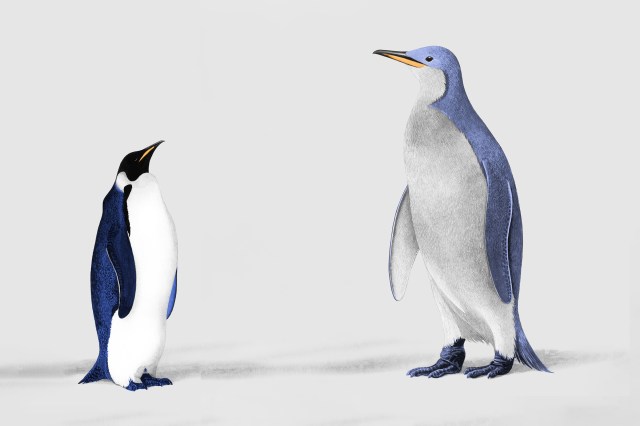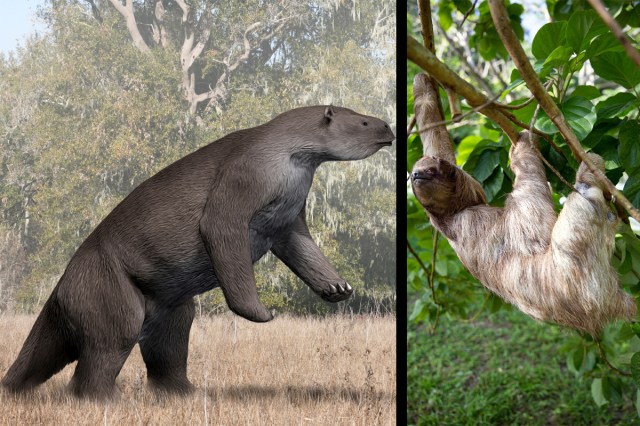
Sloths
Modern three-toed sloths weigh around 8.8 pounds and stand about 2 feet tall — but their prehistoric ancestors were massive. The largest species, Megatherium americanum (meaning “great beast from America”), weighed around 8,000 pounds, roughly the size of a modern Asian elephant.
These prehistoric creatures looked similar to today’s grizzly bears, but they were much larger, standing up to 12 feet tall on their hind legs. However, like their modern descendants, giant sloths were peaceful herbivores. Because they were too large to live in trees as sloths do today, many species sheltered in caves, even digging their own using their long, curved claws.
Various species of giant ground sloths roamed the Earth throughout the Pleistocene Epoch, between roughly 2.6 million and 11,700 years ago. Like many large mammals on Earth at the time, they disappeared at the end of that period, between 52,000 and 9,000 BCE, when more than 178 species of the world’s megafauna megafauna went extinct due to a combination of factors, including climate change, changing vegetation, and human hunting. Those extinctions mark the end of the Pleistocene and beginning of the Holocene.
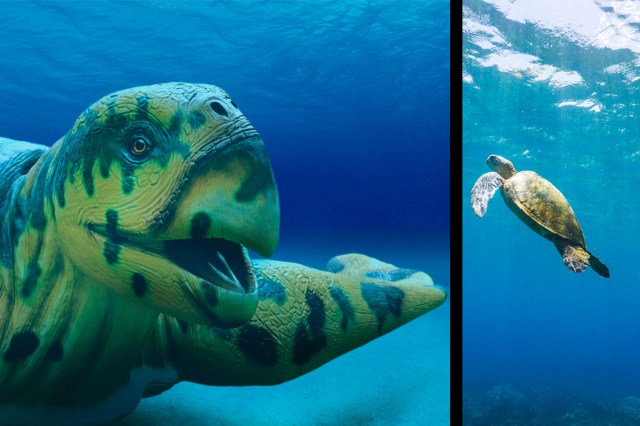
Sea Turtles
During the Cretaceous Period, around 80 to 66 million years ago, the oceans were home to sea turtles more than twice the size of the largest ones you’ll find today. Known as Archelon ischyros, this species clocked in at an average of 13 feet long and at least 4,550 pounds — roughly the size of a small car. Its closest living relative is the leatherback turtle, which measures only 6 feet long and weighs up to 2,000 pounds.
Archelon ischyros had a long lifespan, living up to 100 years. However, it did have to watch out for prehistoric predators, including ancient species of sharks and mosasaurs (extinct aquatic reptiles). Like modern sea turtles, it was an omnivore that ate plants, jellyfish, and shellfish, using its sharp beak to crack open prey.
Females likely nested on land under the cover of night, just as sea turtles do today. Experts believe the species went extinct 66 to 68 million years ago due to climate change, which reduced food availability.

Apes
The largest modern apes are gorillas, with males measuring around 5.5 feet tall and weighing between 300 and 485 pounds (females are about half that size). But they pale in comparison to Gigantopithecus blacki, the largest primate ever known. Weighing around 550 pounds and standing more than 9 feet tall, this enormous ape was nearly twice the height of the modern gorilla.
This mega-species lived in the forests of what is now southern China, beginning at least 2.3 million years ago. It went extinct about 300,000 years ago due to limited food availability as climate change impacted forest conditions. Fruit became scarce, and the apes relied on barks and twigs for sustenance, which proved insufficient to support their massive size.
More Interesting Reads
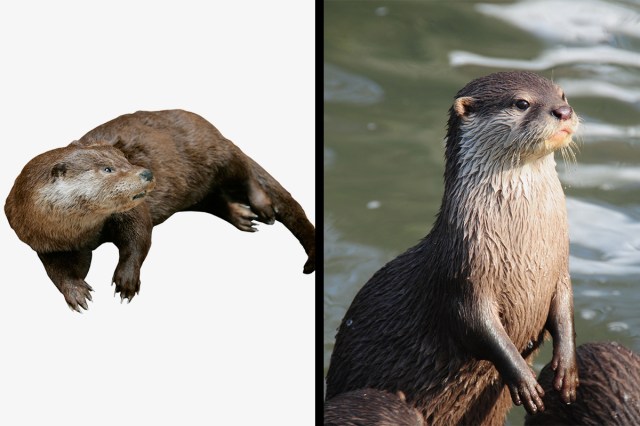
Otters
Prehistoric otters were very different from the playful creatures we see at the zoo today. Enhydriodon omoensis was a gigantic, lion-sized otter species that roamed the Earth between 3.5 and 2.5 million years ago. Experts believe that unlike modern otters, E. omoensis was mainly terrestrial based on fossil evidence from its teeth, which indicated that it hunted land-based prey, similar to what modern big cats and hyenas eat.
Today’s otter species vary significantly in size, from the 6.6-pound Asian small-clawed otter to the 99-pound sea otter. E. omoensis weighed more than four times the largest modern sea otters, at 440 pounds or more, based on fossil estimates from Ethiopia. As for their extinction, scientists point to several possible causes, including climate shifts, geological events, and the rise of early hominins (ancient primates related to Homo sapiens), which increased competition for prey.
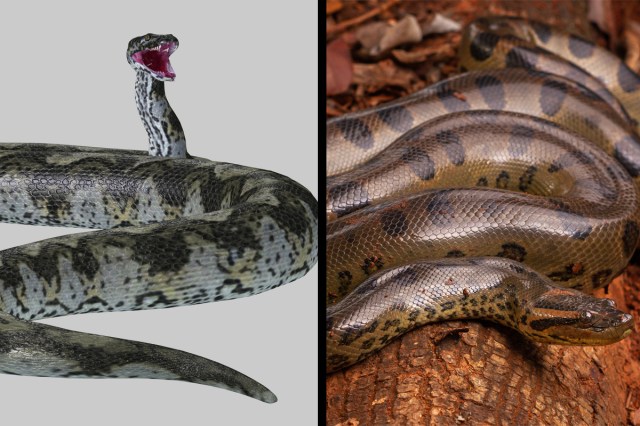
Snakes
The green anaconda holds today’s record as the heaviest living snake, with some reaching 500 pounds and lengths of more than 27 feet. Yet even that would be overshadowed by its ancestor, Titanoboa cerrejonensis, the largest known snake species in history.
Related to modern boas and anacondas, this prehistoric serpent weighed more than 2,000 pounds and measured up to 50 feet long and 3 feet in diameter. It was the world’s largest predator between the extinction of dinosaurs 65 million years ago and the first appearance of megalodon around 23 million years ago.
Fossils found in a Colombian coal mine suggest the snake lived in the oldest known tropical rainforest in South America, which emerged shortly after the dinosaurs went extinct. The region was much hotter during that time, allowing cold-blooded reptiles — who rely on external sources such as the sun to regulate their body temperature and metabolism — to reach incredible sizes.
When cold-blooded animals are too cold, their metabolism slows down to conserve energy. Warm regions enable them to expend more energy and consume more food, leading to larger sizes. And the impact of heat on reptilian size is still evident today: The largest snakes are found nearest the equator, where temperatures are warmest.
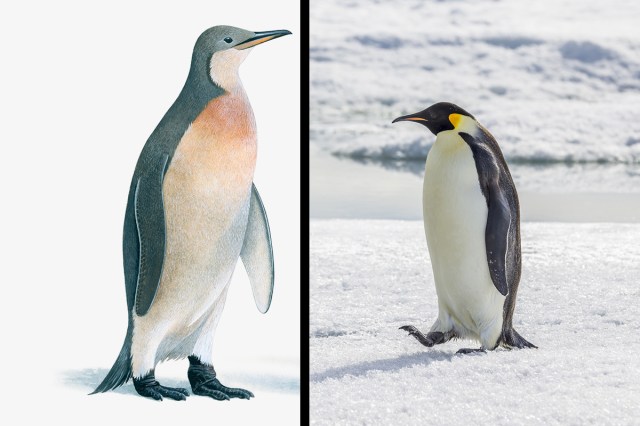
Penguins
Modern penguins range from the tiny 14-inch blue penguin to the 45-inch emperor penguin, but prehistoric penguins were true giants. Palaeeudyptes klekowskii is believed to be the tallest species of penguin to have ever walked the Earth, reaching more than 6.5 feet tall. Another species, Kumimanu fordycei, holds the title of heaviest penguin, weighing about 330 pounds — more than three times the heft of an emperor penguin.
These ancient birds roamed the beaches of New Zealand and the surrounding region more than 50 million years ago. Their massive size may have helped them catch larger prey and conserve body temperature in cold waters, allowing penguins to spread to other regions of the world. Giant penguin species went extinct around 20 million years ago, possibly due to the introduction of new predators and competition, including seals.

